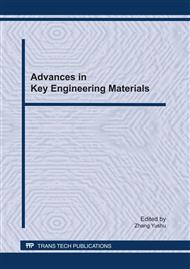[1]
Stiemer, M., Unger, J., Svendsen, B., Blum, H.: An arbitrary Lagrangian Eulerian approach to the three dimensional simulation of electromagnetic forming. Comp. Meth. in App. Mech. and Eng. Vol. 198, pp.1535-1547 (2009).
DOI: 10.1016/j.cma.2009.01.014
Google Scholar
[2]
Fenton, G.K., Daehn, G.S.: Modeling of electromagnetically formed sheet metal. J. Mat. Proc. Techn. (Neth. ). Vol. 75, no. 1-3, pp.6-16 (1998).
Google Scholar
[3]
Karch, C., Roll, K.: Transient Simulation of Electromagnetic Forming of Aluminum Tubes. Advanced Materials Research. Vol. 6-8, pp.639-648 (2005).
Google Scholar
[4]
Mamalis, A.G., Manolakos, D.E., Kladas, A.G., Koumoutsos, A.K.: Physical principles of electromagnetic forming process: a constitutive finite element model. J. Mat. Process. Tech. Vol. 161, Issues 1-2, pp.294-299 (2005).
DOI: 10.1016/j.jmatprotec.2004.07.039
Google Scholar
[5]
Dehra, M.S.: High Velocity Formability and Factors Affecting it. Ph.D. thesis. Ohio State University (2006).
Google Scholar
[6]
Bahmani, M.A., Niayesh, K., Karimi, A.: 3D Simulation of magnetic field distribution in electromagnetic forming systems with field shaper. J. Mat. Process. Tech. Vol. 209, Issue 5, pp.2295-2301 (2009).
DOI: 10.1016/j.jmatprotec.2008.05.024
Google Scholar
[7]
Langemyr, L., Bertilsson, D., Nordmark, A., Persson, P., and Long, J.: Method for assembling the finite element discretization of arbitrary weak equations, involving local or non-local multiphysics couplings. US Patent 7, 519, 518 B2. Apr. 14, (2009).
Google Scholar
[8]
Ravichandran, G., Rosakis, A.J., Hodowany, J., Rosakis, P.: On the Conversion of Plastic Work into Heat during High-Strain-Rate Deformation. American Institute of Physics, CP620, S.C.C.M., pp.557-562 (2001).
Google Scholar
[9]
Zhang, P., Kimchi, M., Shao, H., Gould, J.E., Daehn, G.S.: Analysis of the Electromagnetic Impulse Joining Process with a Field Concentrator. AIP Conf. Proc. Vol. 712, pp.1253-1258 (2004).
Google Scholar
[10]
Johnson, G.R., Cook, W.H.: A Constitutive Model and Data for Metals Subjected to Large Strains, High Strain Rates, and High Temperatures. Proc. of the 7th Intern. Symp. Ballist., American Def. Prep. Org., pp.541-547 (1983).
Google Scholar
[11]
Van-Slycken, J.: Experimental determination of Johnson-Cook parameters for different materials. Internal report University of Gent (2008).
Google Scholar
[12]
Argüeso, M., Robles, G., Sanz, J.: Measurements of high frequency currents with a Rogowski coil. 9th Spanish-Portuguese Congress on Electrical Engineering (2005).
Google Scholar
[13]
Haiping, Y., Chunfeng, L.: Effects of current frequency on electromagnetic tube compression. J. Mat. Process. Tech. Vol. 209, Issue 2, pp.1053-1059 (2009).
DOI: 10.1016/j.jmatprotec.2008.03.011
Google Scholar
[14]
Stadler, G.: Path-following and augmented Lagrangian methods for contact problems in linear elasticity. Journal of Computational and Applied Mathematics, Vol. 203, Issue 2, pp.533-547 (2007).
DOI: 10.1016/j.cam.2006.04.017
Google Scholar


